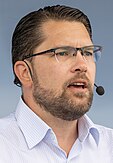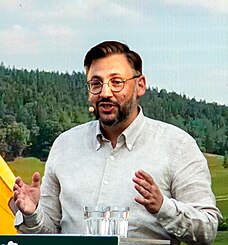2026 Swedish general election
| |||||||||||||||||||||||||||||||||||||||||||||||||||||||||||||||||||||||||||||
All 349 seats to the Riksdag 175 seats needed for a majority | |||||||||||||||||||||||||||||||||||||||||||||||||||||||||||||||||||||||||||||
|---|---|---|---|---|---|---|---|---|---|---|---|---|---|---|---|---|---|---|---|---|---|---|---|---|---|---|---|---|---|---|---|---|---|---|---|---|---|---|---|---|---|---|---|---|---|---|---|---|---|---|---|---|---|---|---|---|---|---|---|---|---|---|---|---|---|---|---|---|---|---|---|---|---|---|---|---|---|
| Opinion polls | |||||||||||||||||||||||||||||||||||||||||||||||||||||||||||||||||||||||||||||
| |||||||||||||||||||||||||||||||||||||||||||||||||||||||||||||||||||||||||||||
| |||||||||||||||||||||||||||||||||||||||||||||||||||||||||||||||||||||||||||||
General elections will be held in Sweden on 13 September 2026 to elect the 349 members of the Riksdag. They in turn will elect the prime minister. In case of a snap election, the parliamentary term would not be reset and general elections would still be held in September 2026 together with regional and municipal elections.[1][2]
Electoral system
[edit]The Riksdag is made up of 349 seats elected by open list proportional representation,[3] with an electoral threshold of 4% of the national vote or alternatively 12% within a single constituency. Of the 349 seats, 310 are elected from 29 constituencies ranging in size from 2 to 40 seats, while the other 39 seats are apportioned nationally as levelling seats to ensure parties that passed the 4% national threshold hold a proportional number of seats; these levelling seats are allocated to particular districts. If a party wins more constituency seats than it is entitled to overall, a redistribution of constituency seats may occur to reduce the number of constituency seats won by that party.[4]
General elections are held on a fixed date, the second Sunday of September, at the same time as the municipal and regional elections.[5][6][7] If early elections are called, the newly elected legislature only serves out the remainder of the four-year term begun by the previous legislature.
Political parties
[edit]The table below lists political parties represented in the Riksdag after the 2022 general election.
| Abbr. | Name | Ideology | Political position | Leader | 2022 result | Current seats | ||
|---|---|---|---|---|---|---|---|---|
| Votes (%) | Seats | |||||||
| S | Swedish Social Democratic Party | Social democracy | Centre-left | Magdalena Andersson | 30.3% | 107 / 349
|
106 / 349
| |
| SD | Sweden Democrats | Right-wing populism | Right-wing to far-right | Jimmie Åkesson | 20.5% | 73 / 349
|
72 / 349
| |
| M | Moderate Party | Liberal conservatism | Centre-right | Ulf Kristersson | 19.1% | 68 / 349
|
68 / 349
| |
| V | Left Party | Socialism | Left-wing | Nooshi Dadgostar | 6.8% | 24 / 349
|
24 / 349
| |
| C | Centre Party | Liberalism | Centre to centre-right | Muharrem Demirok | 6.7% | 24 / 349
|
24 / 349
| |
| KD | Christian Democrats | Christian democracy | Centre-right to right-wing | Ebba Busch | 5.3% | 19 / 349
|
19 / 349
| |
| MP | Green Party | Green politics | Centre-left | Amanda Lind Daniel Helldén |
5.1% | 18 / 349
|
18 / 349
| |
| L | Liberals | Conservative liberalism | Centre-right | Johan Pehrson | 4.6% | 16 / 349
|
16 / 349
| |
| Independents[a] | 0 / 349
|
2 / 349
| ||||||
Opinion polls
[edit]Graphical summary
[edit]
See also
[edit]Notes
[edit]- ^ Elsa Widding (formerly Sweden Democrats) and Jamal El-Haj (formerly Social Democrats)
References
[edit]- ^ "The fundamentals of the electoral system". val.se. Retrieved 19 October 2022.
- ^ Riksdagsförvaltningen. "Elections to the Riksdag". riksdagen.se. Retrieved 19 October 2022.
- ^ "Sweden Riksdagen (Parliament)". Parline. 1 November 2017. Archived from the original on 28 December 2021. Retrieved 31 August 2022.
- ^ "Vallag (2005:837) Svensk författningssamling 2005:2005:837 t.o.m. SFS 2021:1328". Riksdagen (in Swedish). 15 May 2016. Avdelning IV. Fördelning av mandat, 14 kap. Fördelning av mandat, 4 a §. Archived from the original on 30 August 2022. Retrieved 27 August 2022.
- ^ "Elections in Sweden: The way it's done" (PDF). Election Authority. Solna. 7 October 2013. Archived (PDF) from the original on 30 July 2020. Retrieved 31 August 2022.
- ^ "The Swedish electoral system". Valmyndigheten (in Swedish). 16 September 2018. Archived from the original on 16 September 2018. Retrieved 13 September 2018.
- ^ "The 2022 election". Riksdag. 31 August 2022. Archived from the original on 31 August 2022. Retrieved 31 August 2022.
Parliamentary elections will take place on 11 September. On this day voters will have the opportunity to decide which candidates will represent them in the Riksdag over the next four years. On the same day, there are elections to municipalities and regional councils.









